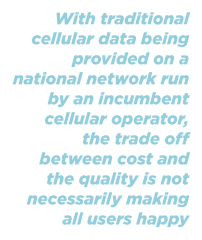As low power wide area (LPWA) radio technologies and LoRa WAN in particular start to take off organisations are benefiting from wider connectivity choices and reduced barriers to entry. These new connectivity options are vital to stimulate further utilisation of IoT, Stream Technologies’ Mohsen Shakoor and Niall Strachan tell George Malim
The arrival into commercial reality of low power radio technologies is democratising access to connectivity. Where once enterprises would have had to engage with cellular network operators or specialist providers of traditional, high power radio networks or rely on the limited characteristics of VHF radio, they are now enabled to deploy LPWA technologies quickly and simply themselves. This gives greater control to the organisation and enables it to maintain security across its deployment sites.
“We’re sat at a different level in the industry to most IoT technology vendors and that means we see different approaches from larger enterprises that are properly considering LPWA as part of their strategy and rolling it out to their customer base,” says Mohsen Shakoor, who leads strategic partnerships for Stream Technologies’ IoT-X platform. “That has been a significant development in the last six to eight months.”
Shakoor says the rise of new connectivity options such as LoRaWAN have made it easier for companies to consider deploying their own wireless networks because there are fewer intricacies involved in setting up networks based on these technologies. “With LoRaWAN, you can own every element inside a privately run network by developing the software and then building and deploying the gateway, or you can outsource various components or all of it,” he adds.
 Part of the appeal of technologies such as this is that these are not theoretical solutions that are untested. “LoRaWAN, for example, was ratified more than a year ago and, while it may have taken some time for vendors to initially develop their solutions to comply with the LoRaWAN specification, in the last year there has been a massive wave of traction due to the solutions and gateways coming to market with full interoperability,” says Niall Strachan, the chief software architect at Stream Technologies. “There has been an acceleration of interest over the last six months and that is becoming progressively more intense as enterprises and network operators use Stream’s IoT-X platform to manage their private or public networks – and not just low power ones.”
Part of the appeal of technologies such as this is that these are not theoretical solutions that are untested. “LoRaWAN, for example, was ratified more than a year ago and, while it may have taken some time for vendors to initially develop their solutions to comply with the LoRaWAN specification, in the last year there has been a massive wave of traction due to the solutions and gateways coming to market with full interoperability,” says Niall Strachan, the chief software architect at Stream Technologies. “There has been an acceleration of interest over the last six months and that is becoming progressively more intense as enterprises and network operators use Stream’s IoT-X platform to manage their private or public networks – and not just low power ones.”
That’s an interesting development that is seeing the stranglehold of cellular networks on IoT device provisioning at the lower data end of the sector start to erode. “The cellular players are beginning to be challenged significantly by LPWA,” confirms Strachan. “Low power challenges the traditional low use cellular market place and, with 2G sunsetting starting to appear in network operators’ strategies, we’re seeing customers migrate to alternative technologies.”
“With traditional cellular data being provided on a national network run by an incumbent cellular operator, the trade off between cost and the quality is not necessarily making all users happy,” he adds. “Some of our customers don’t require all the capabilities of cellular so are now considering or in the process of deploying their own LoRaWAN or paying for access to a public LoRaWAN if it’s available. When customers start to crunch the numbers for deploying a network privately for their exclusive usage it starts to become attractive.”

Both Strachan and Shakoor agree that organisations which choose to build a private network could see it pay for itself by selling access for different solutions. “Customers can start off with a single account that manages a private network but then migrate to a platform as a service offering with customer segregation, subscriber management and billing services to enable the customer to generate revenue from selling network access to third parties and using the profit to subsidise running their own solution on the same network,” Strachan says, emphasising the substantial security and resilience benefits in operating a private network via the IoT-X platform.
The versatility of the low power technologies is part of their appeal. “With LoRaWAN, and LPWA in general, the market will be driven by locations where people need to get data from,” Shakoor says. “Once a LoRaWAN is deployed and solutions are available, it is then relatively easy to begin to commercialise and monetise these solutions as the market appetite gathers momentum.”
Nevertheless, LPWA technologies will not be the only option. Shakoor points to narrowband IoT (NB-IoT), the LPWA technology that is being developed as a 3GPP standard. “The reality is this could enable low power networks over existing cellular infrastructure and that is a good offering to have and co-exist beside other technologies,” he explains. “However, a lot of people still want the ability to deploy privately. In addition, the cost of NB-IoT hasn’t been defined yet so we could see national LoRaWAN networks compete with national NB-IoT networks on both a technical and commercial basis.”
“The main driving factor behind technology choice will be the price, but I don’t believe that if an operator announces an NB-IoT network tomorrow that there will be many solutions available,” he adds. “However, there are already a significant and growing number of LoRaWAN solutions ready to be commercialised.”
Strachan nevertheless sees both technologies coexisting. “NB-IoT is coming and of course we will support and integrate it,” he says. “Our philosophy has always been to remain technology agnostic, supporting the widest range of connectivity protocols. In the future narrowband IoT devices will be managed on our IoT-X platform with the same dashboard, APIs and billing system exactly the same as any existing cellular, satellite or LPWA subscriber today. Because of this approach we can make it very easy set up a network regardless of technology or geographic location. IoT-X also future-proofs the incumbent organisation in terms of its choice and variety of deployed connectivity types.”

approaches from larger enterprises that are
considering or deploying LPWA as part of
their IoT strategy
That is where Shakoor and Strachan see Stream Technologies adding the most value. “We have no axe to grind,” confirms Shakoor. “We want to enable a secure and reliable network connection for all our customers. We won’t push one technology over another. We will recommend services and technologies so long as they are resilient and fit the specific needs of each partner.”
Strachan adds that the company’s wealth of experience in IoT is in strong demand from customers. “People ask for our professional services and advice because we support so many different connectivity options that may suit their requirements, and we have seen many different approaches; both good and bad.” he says. “We have a deep understanding of connectivity and can advise and help find and deploy the right solution that fits their needs. In some occasions there can be a higher level of complexity to consider with a lower power solution. In theory they’re simpler and cheaper to operate but, when people start to think of deploying their own networks and the subsequent management of that network, it can become more difficult than simply paying to use a pre-deployed public network.”
Low power technologies are ushering in a new era of greater connection choices, some of which are bewildering to a market that has been constrained by technical limitation up to now. It’s clear that there are now solutions available to suit most use cases and it is the use cases that will determine technology selection and drive wider adoption. Only a little more guidance is needed to truly enable IoT users to gain the optimum performance from their LPWA strategy. Flexible platforms such as Stream Technologies’ IoT-X platform provide the means by which nonspecialised enterprises can become commercial network operators.
IN ASSOCIATION WITH STREAM TECHNOLOGIES










